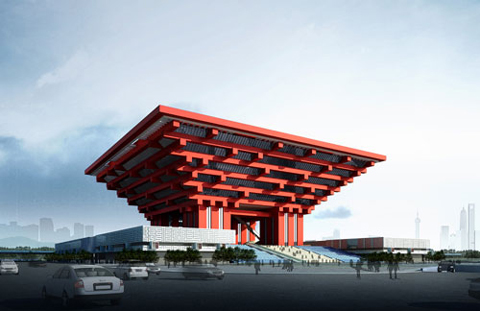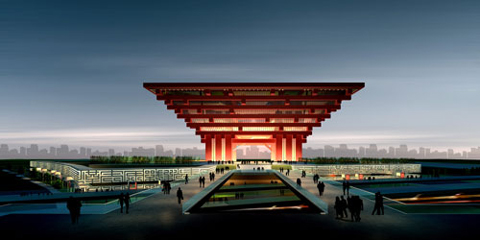
Expo organizers unveil a red, traditional China Pavilion

design of the China Pavilion
World Expo Shanghai organizers unveiled a red, traditional design for the China Pavilion as construction on the structure started this morning.
China Pavilion's design was chosen from 344 entries submitted from all over the world. The final design is made by a joint team from South China University of Technology and Tsinghua University.
The budget of the pavilion is about 1.5 billion yuan (US$203 million), said Ding Hao, deputy director of the Bureau of Shanghai World Expo Coordination, told the press conference after the kicking-off ceremony.
The structure is named as "the Crown of the East" as its most distinct feature is its roof. It will be made of traditional dougong brackets, which have a history of more than 2,000 years.
The dougong style features wooden brackets fixed layer upon layer between the top of a column and a crossbeam. Some magnificent buildings in the Forbidden City and Summer Palace in Beijing feature elaborate dougong-style roofs.
The six-layer dougong roof, with a total of 30-meter height, is actually the exhibition area of the Chinese national pavilion. The 20,000-square-meter exhibition will base on the theme "Chinese wisdom in urban development" and explaining to the visitors Chinese values about harmony, nature and spirit.
The top of the roof features a nine plus nine or sudoku grid, which was a traditional urban planning in ancient Chinese cities, such as Xi'an and Beijing.
Four 20-meter pillars supporting the roof are rising from the top of the 13-meter provincial joint pavilions. The area is a semi-open space where have landscape and greeneries. During daytime, there will also be a smaller sudoku shadow on the square.
The landscaping in the China Pavilion area will be in the Jiangnan-garden style, which can be seen in cities such as Yangzhou or Suzhou, both in Jiangsu Province.
Environment and energy-saving strategies have also been considered in the design, said Dai Liu, president of the Expo Group. For example, the organizers are considering using solar-energy materials to cover the walls of provincial pavilions.
After the six-month Expo, the China Pavilion will become another landmark in Shanghai and holds Chinese cultural exhibitions, said Dai.
The China Pavilion, covering an area of 6.52 hectares, is located in the core area of the Expo site in Pudong.
It is the third permanent pavilion that started construction, following the Expo Center and the Expo theme pavilion. The fourth one, a performance center, will start construction next week.
The China Pavilion includes a national pavilion, a joint pavilion for provinces and cities as well as separate pavilions for Hong Kong, Macau and Taiwan. Each province or city will get a 600-square-meter exhibition area in the pavilion.
Organizers have also launched a worldwide search for exhibition designs. Winning entries will be published in mid April.
Construction of the pavilion will be completed in two years.